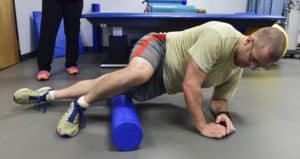Sartorius, the longest muscle in the body, can sometimes cause you problems. The muscle arrangement of the sartorius muscle allows us to raise and turn our knee outward.
Movements that can cause problems with this muscle may be:
- A sudden twisting of a planted foot
- A twisting fall
- Maintaining a contorted position
- Holding the legs up while sitting or sleeping
Common sporting activities such as skating, hockey, swimming, and soccer, commonly use forceful adduction of the hip and this can be a set up for trigger points in this muscle.
Have you experienced a tingling or burning sensation anywhere along your inner thigh or groin? Sartorius originates at the hip bone (anterior superior iliac spine/ASIS), runs diagonally across the thigh to the inner side of the knee and attaches to the shin bone (tibia). Trigger points in this muscle may be the culprit. Many times it causes problems on the inner side of the knee making one think they are having knee problems when in actuality they are having issues with trigger points in the sartorius.
There are a couple of different approaches to addressing pain in this area: foam rolling and trigger point therapy.
Foam Rolling:
You can find foam rollers at most athletic stores if you wish to purchase one or at your local gym if you are a member.

Support your weight on your elbows and knees. Place the foam roller under your belly and in between your thighs with the edge of the roller in contact with your inner hip.
Using your elbows and straight leg, move your body slowly so that the foam roller moves along the inner thigh. It may be very tender, but with each pass of the foam roller, the tenderness should subside. Pressure can be increased if you feel you need more attention in specific areas.
Repeat on the other leg.
Trigger Point:
A trigger point will always refer pain or sensation to another location other than where you are pressing.

Find the place of maximum tenderness. This should be your trigger point. When located, press down into the center of it and maintain the pressure for no less than one minute and no longer than two minutes or until you feel the tissue soften. Release the pressure gradually, and without moving your finger. Rest and then repeat this multiple times.
If you have pain in your sartorius, please try both foam rolling and trigger point therapy. If you are not plagued by this problem, you probably know someone who is.
Try this technique on yourself or on someone else and let us know your results via our blog. Check their range of motion before and after to see what change you have created.










Comments are closed.